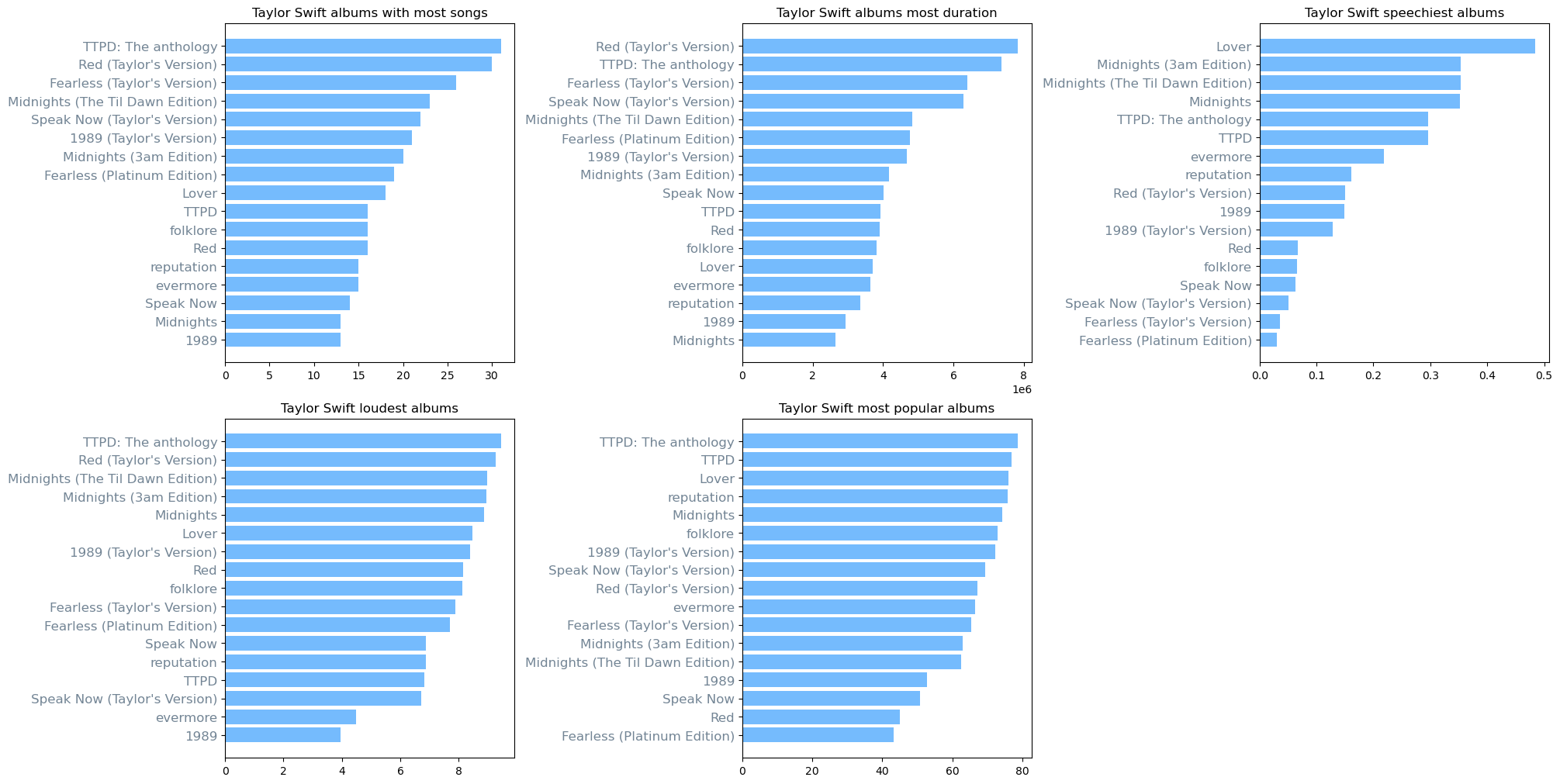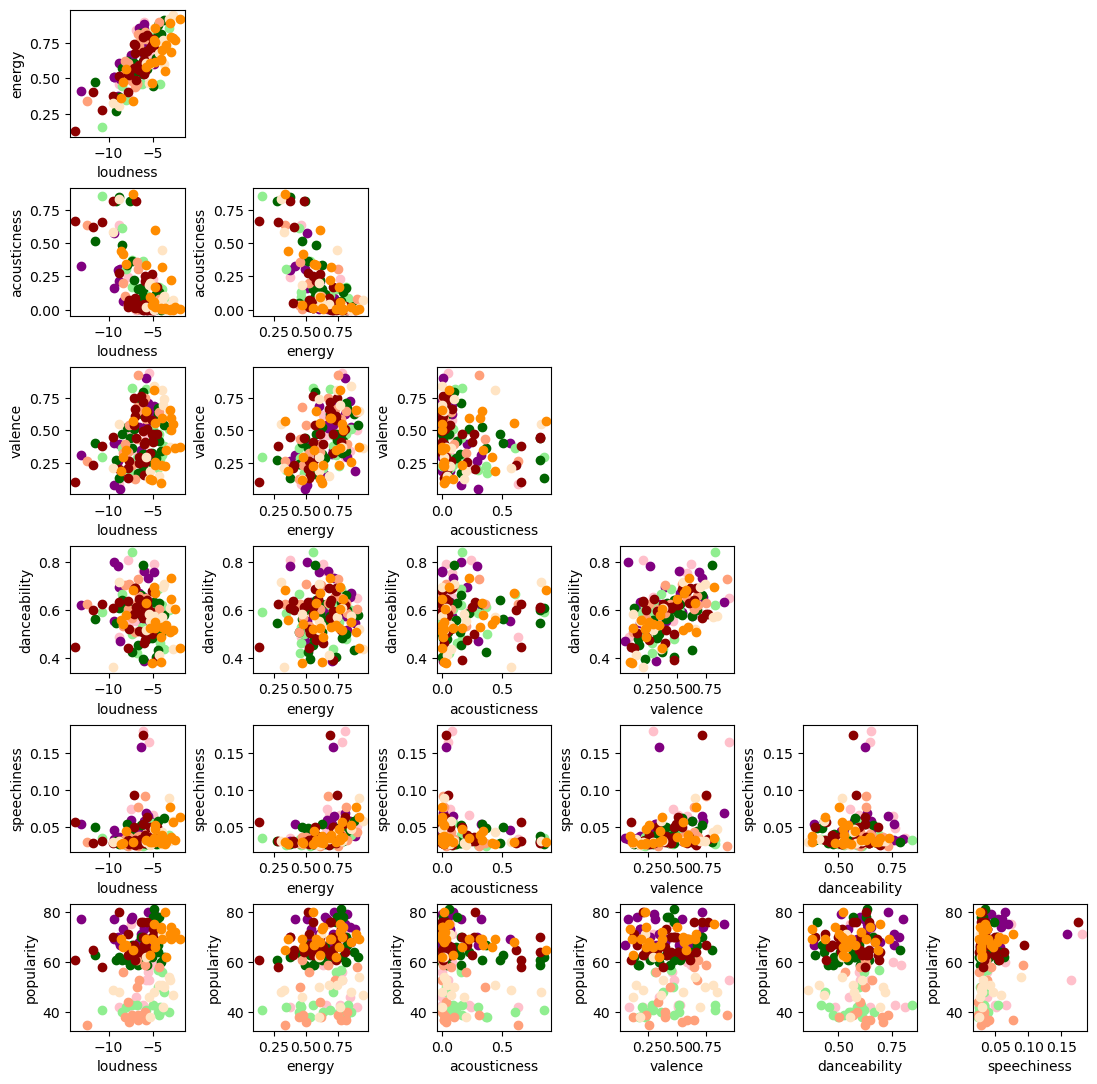# dataset from https://www.kaggle.com/datasets/arthurboari/taylor-swift-spotify-data
#df = pd.read_csv('Taylor Swift Spotify Data 07-23.csv')
# dataset from https://www.kaggle.com/datasets/jarredpriester/taylor-swift-spotify-dataset
import warnings
warnings.simplefilter(action='ignore', category=FutureWarning)
import pandas as pd
import matplotlib.pyplot as plt
import numpy as np
from sklearn.linear_model import LinearRegression
total_records = pd.read_csv('taylor_swift_spotify.csv')
Basic dataframe understanding
Let us get the frameheader to check what is located inside.
total_records.head()
| Unnamed: 0 | name | album | release_date | track_number | id | uri | acousticness | danceability | energy | instrumentalness | liveness | loudness | speechiness | tempo | valence | popularity | duration_ms | |
|---|---|---|---|---|---|---|---|---|---|---|---|---|---|---|---|---|---|---|
| 0 | 0 | Fortnight (feat. Post Malone) | THE TORTURED POETS DEPARTMENT: THE ANTHOLOGY | 2024-04-19 | 1 | 6dODwocEuGzHAavXqTbwHv | spotify:track:6dODwocEuGzHAavXqTbwHv | 0.5020 | 0.504 | 0.386 | 0.000015 | 0.0961 | -10.976 | 0.0308 | 192.004 | 0.281 | 82 | 228965 |
| 1 | 1 | The Tortured Poets Department | THE TORTURED POETS DEPARTMENT: THE ANTHOLOGY | 2024-04-19 | 2 | 4PdLaGZubp4lghChqp8erB | spotify:track:4PdLaGZubp4lghChqp8erB | 0.0483 | 0.604 | 0.428 | 0.000000 | 0.1260 | -8.441 | 0.0255 | 110.259 | 0.292 | 79 | 293048 |
| 2 | 2 | My Boy Only Breaks His Favorite Toys | THE TORTURED POETS DEPARTMENT: THE ANTHOLOGY | 2024-04-19 | 3 | 7uGYWMwRy24dm7RUDDhUlD | spotify:track:7uGYWMwRy24dm7RUDDhUlD | 0.1370 | 0.596 | 0.563 | 0.000000 | 0.3020 | -7.362 | 0.0269 | 97.073 | 0.481 | 80 | 203801 |
| 3 | 3 | Down Bad | THE TORTURED POETS DEPARTMENT: THE ANTHOLOGY | 2024-04-19 | 4 | 1kbEbBdEgQdQeLXCJh28pJ | spotify:track:1kbEbBdEgQdQeLXCJh28pJ | 0.5600 | 0.541 | 0.366 | 0.000001 | 0.0946 | -10.412 | 0.0748 | 159.707 | 0.168 | 82 | 261228 |
| 4 | 4 | So Long, London | THE TORTURED POETS DEPARTMENT: THE ANTHOLOGY | 2024-04-19 | 5 | 7wAkQFShJ27V8362MqevQr | spotify:track:7wAkQFShJ27V8362MqevQr | 0.7300 | 0.423 | 0.533 | 0.002640 | 0.0816 | -11.388 | 0.3220 | 160.218 | 0.248 | 80 | 262974 |
Let us replace the capital lettered long album with smething small and readable.
total_records = total_records.replace('THE TORTURED POETS DEPARTMENT', 'TTPD', regex=True)
total_records = total_records.replace('THE ANTHOLOGY', 'The anthology', regex=True)
Filter unwanted albums to get the albums only. This involves the Big Machine versions and Taylor’s versions.
# filter the rows that contain the substring, this is to remove entries which aren't original albums but special renditions and such
substring = ['Deluxe','Disney', 'Live','Stadium','delux','International','Piano']
pattern = '|'.join(substring)
filter = total_records['album'].str.contains(pattern)
filtered_df = total_records[~filter]
print(filtered_df['album'].unique())
filtered_df.groupby(['album']).size().sum()
['TTPD: The anthology' 'TTPD' "1989 (Taylor's Version)"
"Speak Now (Taylor's Version)" 'Midnights (The Til Dawn Edition)'
'Midnights (3am Edition)' 'Midnights' "Red (Taylor's Version)"
"Fearless (Taylor's Version)" 'evermore' 'folklore' 'Lover' 'reputation'
'1989' 'Red' 'Speak Now' 'Fearless (Platinum Edition)']
328
Album summaries
This will be album summary. This should act as a one stop shop to quickly get an overview of what’s happening for each album.
album_summary=pd.DataFrame()
album_summary['album']=filtered_df.groupby(['album'])['speechiness'].min().keys()
album_summary['size']=list(filtered_df.groupby(['album']).size())
album_summary['speechiness_min']=list(filtered_df.groupby(['album'])['speechiness'].min())
album_summary['speechiness_max']=list(filtered_df.groupby(['album'])['speechiness'].max())
album_summary['loudness_min']=list(filtered_df.groupby(['album'])['loudness'].min())
album_summary['loudness_max']=list(filtered_df.groupby(['album'])['loudness'].max())
album_summary['total_duration_ms']=list(filtered_df.groupby(['album'])['duration_ms'].sum())
album_summary['total_duration_HMS'] = pd.to_datetime(album_summary['total_duration_ms'], unit='ms').dt.strftime('%H:%M:%S:%f').str[:-3]
album_summary['mean_popularity'] = list(filtered_df.groupby(['album'])['popularity'].mean())
album_summary
| album | size | speechiness_min | speechiness_max | loudness_min | loudness_max | total_duration_ms | total_duration_HMS | mean_popularity | |
|---|---|---|---|---|---|---|---|---|---|
| 0 | 1989 | 13 | 0.0324 | 0.1810 | -8.768 | -4.807 | 2927864 | 00:48:47:864 | 52.692308 |
| 1 | 1989 (Taylor's Version) | 21 | 0.0303 | 0.1590 | -13.187 | -4.803 | 4678327 | 01:17:58:327 | 72.190476 |
| 2 | Fearless (Platinum Edition) | 19 | 0.0239 | 0.0549 | -10.785 | -3.096 | 4766608 | 01:19:26:608 | 43.157895 |
| 3 | Fearless (Taylor's Version) | 26 | 0.0263 | 0.0628 | -11.548 | -3.669 | 6392490 | 01:46:32:490 | 65.269231 |
| 4 | Lover | 18 | 0.0344 | 0.5190 | -12.566 | -4.105 | 3711381 | 01:01:51:381 | 75.944444 |
| 5 | Midnights | 13 | 0.0349 | 0.3870 | -15.512 | -6.645 | 2648338 | 00:44:08:338 | 74.153846 |
| 6 | Midnights (3am Edition) | 20 | 0.0342 | 0.3870 | -15.512 | -6.557 | 4169264 | 01:09:29:264 | 62.850000 |
| 7 | Midnights (The Til Dawn Edition) | 23 | 0.0342 | 0.3870 | -15.512 | -6.548 | 4835165 | 01:20:35:165 | 62.434783 |
| 8 | Red | 16 | 0.0243 | 0.0916 | -12.411 | -4.267 | 3895394 | 01:04:55:394 | 45.000000 |
| 9 | Red (Taylor's Version) | 30 | 0.0250 | 0.1750 | -13.778 | -4.516 | 7839830 | 02:10:39:830 | 67.233333 |
| 10 | Speak Now | 14 | 0.0258 | 0.0887 | -9.531 | -2.641 | 4021982 | 01:07:01:982 | 50.714286 |
| 11 | Speak Now (Taylor's Version) | 22 | 0.0263 | 0.0771 | -8.641 | -1.927 | 6284051 | 01:44:44:051 | 69.454545 |
| 12 | TTPD | 16 | 0.0255 | 0.3220 | -13.961 | -7.123 | 3915705 | 01:05:15:705 | 77.000000 |
| 13 | TTPD: The anthology | 31 | 0.0255 | 0.3220 | -13.961 | -4.514 | 7358744 | 02:02:38:744 | 78.774194 |
| 14 | evermore | 15 | 0.0264 | 0.2450 | -12.077 | -7.589 | 3645210 | 01:00:45:210 | 66.400000 |
| 15 | folklore | 16 | 0.0253 | 0.0916 | -15.065 | -6.942 | 3816587 | 01:03:36:587 | 72.812500 |
| 16 | reputation | 15 | 0.0354 | 0.1960 | -12.864 | -5.986 | 3345300 | 00:55:45:300 | 75.733333 |
Simple visual representation
Which of her albums are longest, most popular, or loudest? Here are histograms representing that. For each histogram the corresponding criteria is sorted upon. It is clear that Taylor’s versions are considerably more popular than the Big Machine versions.
fig, ax = plt.subplots(2,3, figsize = (20,10), layout="constrained" )#, sharex=True)#, sharey=True)
fig.delaxes(ax[1][2])
temp_df=pd.DataFrame()
temp_df['album']=album_summary['album'].astype(str)
temp_df['size']=album_summary['size']
temp_df['total_duration_ms']=album_summary['total_duration_ms']
temp_df['speechiness']= abs(album_summary['speechiness_min']-album_summary['speechiness_max'])
temp_df['loudness']= abs(album_summary['loudness_min'])-abs(album_summary['loudness_max'])
temp_df['popularity']= album_summary['mean_popularity']
criteria = ['size', 'total_duration_ms', 'speechiness', 'loudness','popularity']
plot_title = ['Taylor Swift albums with most songs','Taylor Swift albums most duration','Taylor Swift speechiest albums',\
'Taylor Swift loudest albums', 'Taylor Swift most popular albums']
for i in range(len(criteria)):
temp_df = temp_df.sort_values(by=[criteria[i]])
#print(temp_df['loudness'])
if i <= 2:
#ax[0][0]=temp_df.plot.barh(color = 'xkcd:steel')
ax[0][i].barh(temp_df['album'],temp_df[criteria[i]], color = 'xkcd:sky blue')
ax[0][i].set_yticks(range(len(list(temp_df['album']))), temp_df['album'], fontsize=12, color = 'xkcd:steel');
ax[0][i].set_title(plot_title[i]);
else:
#ax[0][0]=temp_df.plot.barh(color = 'xkcd:steel')
ax[1][i-3].barh(temp_df['album'],temp_df[criteria[i]], color = 'xkcd:sky blue')
ax[1][i-3].set_yticks(range(len(list(temp_df['album']))), temp_df['album'], fontsize=12, color = 'xkcd:steel');
ax[1][i-3].set_title(plot_title[i]);

Starting to gain some insights
I want to get some insights into these variables without knowing the definitions. This is not a very good idea of course but I want to first know if some of the variables in the dataframe are correlated. If so which ones? Here I also make first contact with scikit-learn and use the LinearRegression model to check for the correlation. What I use here is the $R^2$ which should be the square of the correlation coefficient. I also show the model coefficient which should tell us if the data is correlated or anticorrelated.
import matplotlib.pyplot as plt
import numpy as np
xvals = ['loudness', 'energy', 'speechiness', 'danceability','acousticness','liveness','tempo','valence','popularity','instrumentalness']
yvals = ['loudness', 'energy', 'speechiness', 'danceability','acousticness','liveness','tempo','valence','popularity','instrumentalness']
newxcol = []
newycol = []
for i in range(len(xvals)):
for j in range(len(yvals)):
if i >=j: continue
xcol = filtered_df[xvals[i]]
ycol = filtered_df[yvals[j]]
x = np.array(list(xcol)).reshape((-1,1))
y = np.array(list(ycol))
model = LinearRegression().fit(x,y)
rsq = model.score(x, y)
if rsq > 0.1:
print(f"overall coefficient of determination for : {xvals[i], yvals[j], rsq, model.coef_[0]}")
newxcol.append(xvals[i])
newycol.append(yvals[j])
overall coefficient of determination for : ('loudness', 'energy', 0.6429955130707232, 0.05193931977241491)
overall coefficient of determination for : ('loudness', 'acousticness', 0.5417812284681403, -0.08155677230919023)
overall coefficient of determination for : ('loudness', 'valence', 0.14387666725197357, 0.02614074917825036)
overall coefficient of determination for : ('energy', 'acousticness', 0.47234085351213695, -1.1756648168955814)
overall coefficient of determination for : ('energy', 'valence', 0.24517689187957725, 0.5268297925424761)
Does the above analysis look good? Let’s inspect visually by plotting the corresponding variables against each other. Note that this part of the code is a bit dirty, I think this can be cleaned up but I will get to it as I go ahead in this project.
The plots below show exactly what we expect from numbers above e.g. energy and loudness are directly correlated to each other but loudness and acousticness are anticorrelated. So it would seem that my understanding of how sklearn linear regression should behave is not too wrong.
# this needs to be iterated over fixed list of colors
import matplotlib.pyplot as plt
import numpy as np
from itertools import cycle
import sys
from matplotlib.pyplot import cm
color = cm.rainbow(np.linspace(0, 1, 19))
xvals = ['loudness', 'energy','acousticness','valence']
yvals = ['loudness', 'energy','acousticness','valence']
fig, ax = plt.subplots(len(xvals), len(yvals), figsize = (24,17), layout="constrained" )#, sharex=True)#, sharey=True)
plot = []
labels = []
for i in range(len(xvals)):
for j in range(len(yvals)):
try:
if j >= i: fig.delaxes(ax[i][j])
except: continue
k = 0
for x in filtered_df.groupby(['album']).groups:
#for name, x in filtered_df.groupby(['album']):
xcol = filtered_df.groupby(['album']).get_group(x)[xvals[i]]
ycol = filtered_df.groupby(['album']).get_group(x)[yvals[j]]
album = list(filtered_df.groupby(['album']).get_group(x)['album'])[0]
#ax[i][j].scatter(xcol, ycol, color=color[k], label = list(name[0]))
ax[i][j].scatter(xcol, ycol, color=color[k], label = album)
#ax[i][j].scatter(xcol, ycol, color=next(color), label = list(filtered_df.groupby(['album']).get_group(x)['album'])[0])
ax[i][j].set_xlabel(xvals[i])
ax[i][j].set_ylabel(yvals[j])
if (i == 1 and j == 0): ax[i][j].legend(bbox_to_anchor=(2.2, 1),loc='upper left')#, borderaxespad=0.)
k = k + 1
fig.subplots_adjust(bottom=0.2)
plt.tight_layout()
plt.show()
/var/folders/zf/vn2shr2j6x9_qkg68dw_nk4c0000gn/T/ipykernel_53361/1207867289.py:36: UserWarning: This figure was using a layout engine that is incompatible with subplots_adjust and/or tight_layout; not calling subplots_adjust.
fig.subplots_adjust(bottom=0.2)
/var/folders/zf/vn2shr2j6x9_qkg68dw_nk4c0000gn/T/ipykernel_53361/1207867289.py:37: UserWarning: Tight layout not applied. tight_layout cannot make Axes width small enough to accommodate all Axes decorations
plt.tight_layout()
/var/folders/zf/vn2shr2j6x9_qkg68dw_nk4c0000gn/T/ipykernel_53361/1207867289.py:37: UserWarning: The figure layout has changed to tight
plt.tight_layout()

Big Machine versions against Taylor’s versions
What are the differences in Taylor’s versions and the Big Machines versions? I want to answer this question. I didn’t get to it completely because of two reasons: 1) The data was actually a bit faulty in that some of the entries have the wrong encoding for apostrophy. I checked it using ‘cat -v’ command. It was easy to go into the text file and clean it up, but I would like to have an automated way to clean it up. I didn’t find it yet. 2) I still haven’t found a way to filter on the same songs between Big Machine and Taylor’s versions. It would be foolish to compare entire albums here because Taylor’s versions includes considerably more songs.
What I can definitely say is that there is no obvious difference between Taylor’s versions and Big Machine’s versions. This is something you know of course if you are a Swifty. I think this is where her fanbase loyalty really shines.
xvals = ['loudness', 'energy','acousticness','valence','danceability','speechiness','popularity']
yvals = ['loudness', 'energy','acousticness','valence','danceability','speechiness','popularity']
color_BM = ['pink','lightgreen','lightsalmon','bisque']
color_Taylor = ['purple','darkgreen','darkred','darkorange']
temp_df=pd.DataFrame()
substring = ['1989', 'Fearless', 'Red', 'Speak Now']
pattern = '|'.join(substring)
filter = filtered_df['album'].str.contains(pattern)
temp_df = filtered_df[filter]
filter = temp_df['album'].str.contains('Version')
BM_version_temp = temp_df[~filter]
BM_version = BM_version_temp.replace('Fearless \(Platinum Edition\)', 'Fearless', regex=True)
Taylor_version = temp_df[filter]
fig, ax = plt.subplots(len(xvals),len(yvals), figsize = (12,12), layout="constrained" )
for i in range(len(xvals)):
for j in range(len(yvals)):
try:
if j >= i: fig.delaxes(ax[i][j])
except: continue
k = 0
for BM_name, BM_group in BM_version.groupby(['album']):
xcol = list(BM_group[xvals[i]])
ycol = list(BM_group[yvals[j]])
ax[i][j].scatter(ycol, xcol, color=color_BM[k])
for Taylor_name, Taylor_group in Taylor_version.groupby(['album']):
if list(BM_name)[0] in list(Taylor_name)[0]:
xcol = list(Taylor_group[xvals[i]])
ycol = list(Taylor_group[yvals[j]])
ax[i][j].scatter(ycol, xcol, color=color_Taylor[k])
ax[i][j].set_xlabel(xvals[j])
ax[i][j].set_ylabel(yvals[i])
k = k + 1

Getting to statistics 101
Let’s try to extract some statistics from her data. I plot here the correlation coefficient between the numerical data. I find two surprises 1) I don’t understand why track_number should be related to acusticness. A simple plot didn’t show any such correlation. This needs investigation. 2) Some of the correlation coefficients don’t match with the scikit-learn linear regression analysis, even if I account for the $R^2$ vs $R$ definitions. Perhaps the two are done differently, I need to find this out.
f = plt.figure(figsize=(6, 6))
Taylor_numbers = Taylor_version.drop(['album', 'name','release_date','id','uri','Unnamed: 0'], axis=1)
corr=Taylor_numbers.corr()
corr.style.background_gradient(cmap='coolwarm').format("{:.2f}")
| track_number | acousticness | danceability | energy | instrumentalness | liveness | loudness | speechiness | tempo | valence | popularity | duration_ms | |
|---|---|---|---|---|---|---|---|---|---|---|---|---|
| track_number | 1.00 | 0.40 | -0.00 | -0.26 | -0.15 | -0.22 | -0.40 | -0.04 | -0.08 | -0.08 | -0.31 | 0.13 |
| acousticness | 0.40 | 1.00 | 0.11 | -0.69 | -0.09 | -0.02 | -0.60 | -0.19 | -0.09 | -0.15 | -0.32 | 0.15 |
| danceability | -0.00 | 0.11 | 1.00 | -0.01 | -0.07 | -0.18 | -0.17 | -0.02 | -0.36 | 0.44 | 0.14 | -0.25 |
| energy | -0.26 | -0.69 | -0.01 | 1.00 | 0.13 | 0.12 | 0.74 | 0.31 | 0.04 | 0.45 | 0.27 | -0.32 |
| instrumentalness | -0.15 | -0.09 | -0.07 | 0.13 | 1.00 | -0.05 | 0.06 | 0.02 | -0.08 | -0.07 | 0.19 | -0.04 |
| liveness | -0.22 | -0.02 | -0.18 | 0.12 | -0.05 | 1.00 | 0.22 | -0.03 | 0.07 | -0.09 | -0.06 | 0.00 |
| loudness | -0.40 | -0.60 | -0.17 | 0.74 | 0.06 | 0.22 | 1.00 | 0.06 | 0.07 | 0.28 | 0.20 | -0.04 |
| speechiness | -0.04 | -0.19 | -0.02 | 0.31 | 0.02 | -0.03 | 0.06 | 1.00 | 0.32 | 0.30 | 0.17 | -0.26 |
| tempo | -0.08 | -0.09 | -0.36 | 0.04 | -0.08 | 0.07 | 0.07 | 0.32 | 1.00 | 0.05 | -0.14 | -0.02 |
| valence | -0.08 | -0.15 | 0.44 | 0.45 | -0.07 | -0.09 | 0.28 | 0.30 | 0.05 | 1.00 | 0.13 | -0.38 |
| popularity | -0.31 | -0.32 | 0.14 | 0.27 | 0.19 | -0.06 | 0.20 | 0.17 | -0.14 | 0.13 | 1.00 | 0.06 |
| duration_ms | 0.13 | 0.15 | -0.25 | -0.32 | -0.04 | 0.00 | -0.04 | -0.26 | -0.02 | -0.38 | 0.06 | 1.00 |
<Figure size 600x600 with 0 Axes>
xvals = ['loudness', 'energy', 'speechiness', 'danceability','acousticness','liveness','tempo','valence','popularity','instrumentalness','track_number']
yvals = ['loudness', 'energy', 'speechiness', 'danceability','acousticness','liveness','tempo','valence','popularity','instrumentalness','track_number']
newxcol = []
newycol = []
for i in range(len(xvals)):
for j in range(len(yvals)):
if i >=j: continue
xcol = filtered_df[xvals[i]]
ycol = filtered_df[yvals[j]]
x = np.array(list(xcol)).reshape((-1,1))
y = np.array(list(ycol))
model = LinearRegression().fit(x,y)
rsq = model.score(x, y)
if rsq > 0.1:
print(f"overall coefficient of determination for : {xvals[i], yvals[j], np.sqrt(rsq), model.coef_[0]}")
newxcol.append(xvals[i])
newycol.append(yvals[j])
overall coefficient of determination for : ('loudness', 'energy', 0.8018700100831326, 0.05193931977241491)
overall coefficient of determination for : ('loudness', 'acousticness', 0.7360578974972962, -0.08155677230919023)
overall coefficient of determination for : ('loudness', 'valence', 0.3793107792456913, 0.02614074917825036)
overall coefficient of determination for : ('energy', 'acousticness', 0.6872705824579842, -1.1756648168955814)
overall coefficient of determination for : ('energy', 'valence', 0.4951534023709998, 0.5268297925424761)
